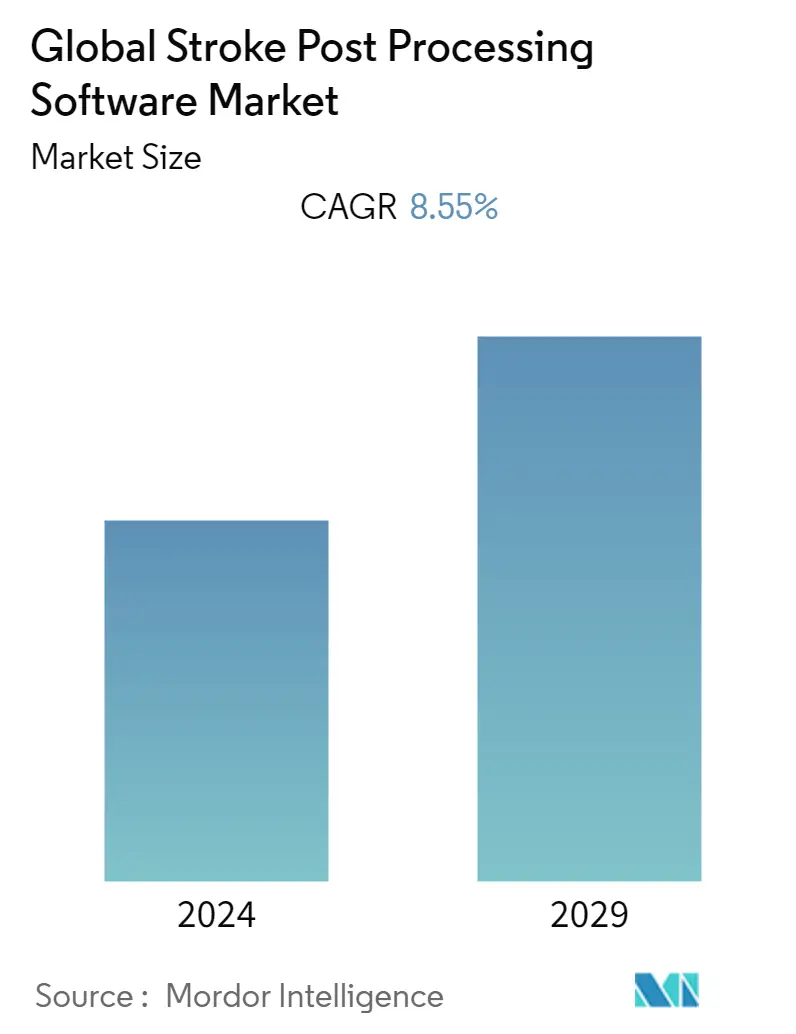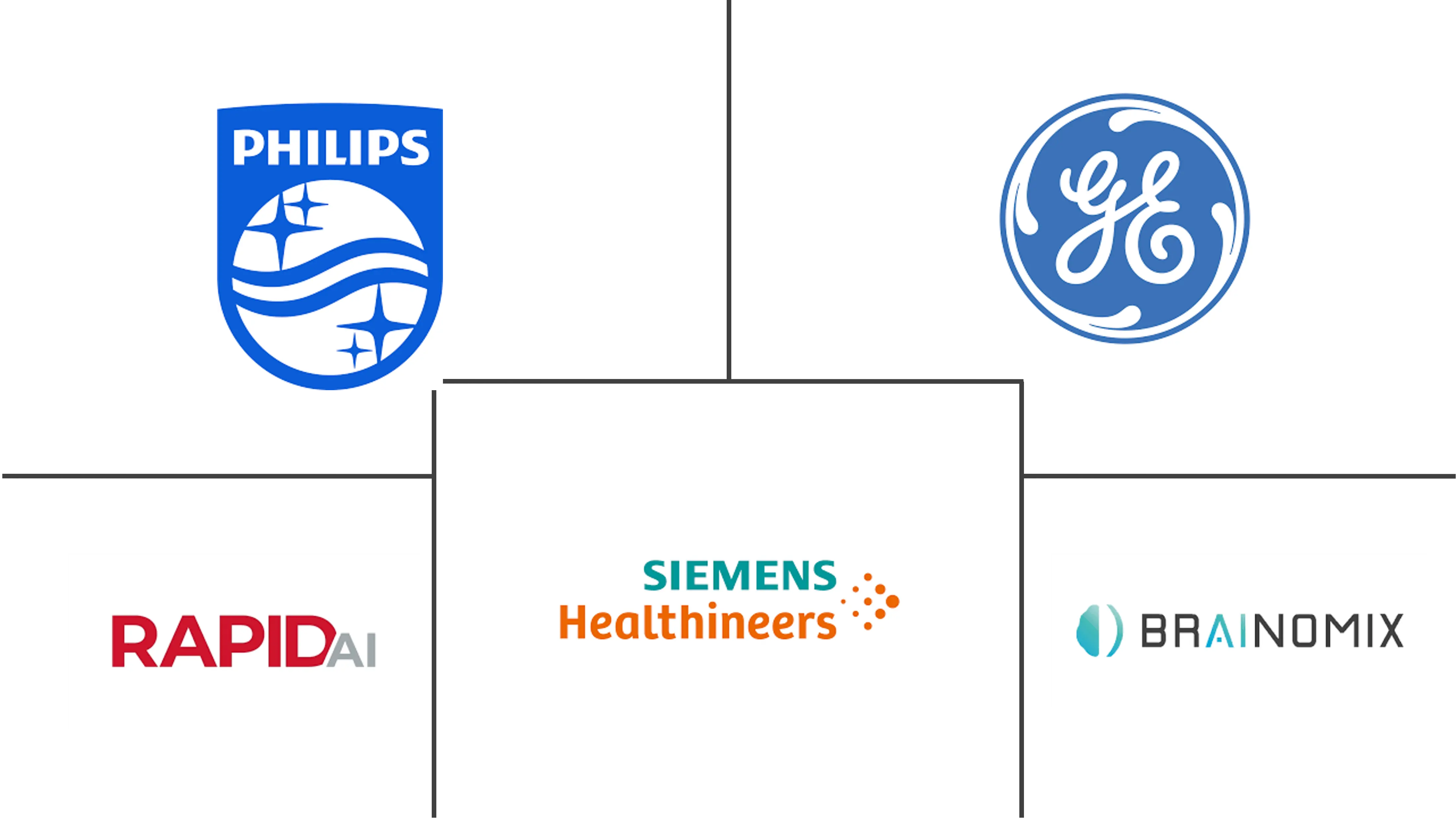Market Size of Global Stroke Post Processing Software Industry

| Study Period | 2019 - 2029 |
| Base Year For Estimation | 2023 |
| Forecast Data Period | 2024 - 2029 |
| CAGR | 8.55 % |
| Fastest Growing Market | Asia-Pacific |
| Largest Market | North America |
Major Players
*Disclaimer: Major Players sorted in no particular order |
Stroke Post Processing Software Market Analysis
The Stroke Post Processing Software Market is projected to register a CAGR of 8.55% during the forecast period (2022-2027).
During the COVID-19 pandemic, most of the hospital-based care was shifted to caring for coronavirus-infected patients, putting a transient and slight dent in growth. However, as more COVID patients suffered strokes and other brain-related issues, the demand for stroke post-processing software grew. Due to the sensitive nature of the stroke, however, market conditions recovered quickly. Frontline workers can now make better treatment decisions because of the availability of helpful post-stroke management software. AI-Artificial intelligence-driven stroke management software has seen a considerable surge in popularity because of technological improvements. Reduced hospital admissions of stroke patients were noted during the initial COVID-19 outbreak. It was because people were afraid of infection during a period of segregation and lockdown. A decline in acute stroke hospital admissions has been recorded in many regions, indicating that many patients with mild and severe strokes are also avoiding hospitalization. According to data from the National Institute of Health-2020, patient admission, treatment, and discharge volumes for acute stroke therapy in central and south Texas have reduced dramatically since COVID-19-related lockdown orders were issued.
Stroke management systems and software are in higher demand as the number of strokes rises. According to the Centers for Disease Control and Prevention (CDC), stroke is expected to account for one in every six deaths in the United States by 2020. The software systems provide better treatment outcomes for stroke victims. The AI-Artificial intelligence-based approach aids stroke specialists in detecting major vascular occlusions, allowing patients to be referred and transferred more quickly. The use of stroke post-processing software allows for the creation of more efficient pathways, faster treatment decisions, and improved patient outcomes. Technological improvements, particularly in the realm of healthcare IT solutions, have considerably improved software adoption by healthcare professionals while also lowering the likelihood of post-stroke problems.
The stroke post-processing software generates more detailed images with synchronized data, assisting in the diagnosis of the stroke's effect or progression and allowing physicians to make more rapid clinical judgments. As a result, investing in it to improve quality and updates can have a huge impact on market growth. For instance, Hospital software ViewPoint 6 Direct Connect by GE Healthcare helps reduce dictation by auto-populating ultrasound measurements and report details directly into the radiology reporting system and makes the physicians' work easier. According to the Centers for Disease Control and Prevention-2022, a stroke occurs every 40 seconds in the United States. Someone dies of a stroke every 3.5 minutes. In both developed and emerging nations, government policies that promote the overall adoption of healthcare IT solutions to improve healthcare outcomes operate as a primary reinforcing factor for the industry. Increased healthcare awareness, an increase in the frequency of diabetes, an increase in the number of tobacco users, and an increase in the senior population are all driving market expansion.
Furthermore, technical developments in stroke detection and treatment add to the market's growth. Artificial intelligence and machine learning are projected to become commonplace as the healthcare business continues to rely on technological breakthroughs. More sophisticated ways of detecting, diagnosing, and treating stroke patients are expected because of this. This will force service providers to implement highly advanced stroke post-processing software. However, high diagnostic and treatment costs, as well as a lack of reimbursement regulations, are projected to limit market expansion. On the other hand, continuous R&D in the field of stroke management is likely to provide the profitable potential for market expansion. Artificial intelligence and other technological developments have become more widely adopted across important healthcare settings as their penetration has increased. All the factors contribute to accelerating the market growth during the forecast period.
Stroke Post Processing Software Industry Segmentation
As per the scope of this report, Stroke post-processing software allows doctors to make more informed decisions about stroke patients. AI-powered software solutions allow for faster patient transfers. When a blood artery in the brain ruptures and bleeds, or when the blood supply to the brain is cut off, a stroke ensues. Blood and oxygen are unable to reach the brain's tissues due to the rupture or obstruction. Transient ischemic attack, ischemic stroke, and hemorrhagic stroke are the most common three forms of strokes that occur around the world. The Stroke Post Processing Software Market is segmented by Installation (Desktop and Mobile Phones & Tablets), By Modality (CT scan and MRI), By Type (Ischemic Stroke, Hemorrhagic Stroke, and Others), By End user (Hospitals & Clinics, Specialty Centers, and Others) and Geography (North America, Europe, Asia-Pacific, Middle-East and Africa, and South America). The market report also covers the estimated market sizes and trends for 17 different countries across major regions, globally. The report offers the value (in USD million) for the above segments.
| By Technology | |
| Polymerase Chain Reaction (PCR) | |
| Next Generation Sequencing (NGS) | |
| Microarrays | |
| Others |
| By Product Type | |
| Instruments | |
| Reagents and Consumables | |
| Services |
| By End-user | |
| Drug Discovery | |
| Diagnostic Laboratories | |
| Academic Research Centers |
| Geography | ||||||||
| ||||||||
| ||||||||
| ||||||||
| ||||||||
|
Global Stroke Post Processing Software Market Size Summary
The Stroke Post Processing Software Market is experiencing significant growth, driven by the increasing prevalence of strokes and advancements in healthcare technology. The market is characterized by the integration of artificial intelligence and machine learning, which enhance the detection, diagnosis, and treatment of stroke patients. These technological improvements have led to the development of more efficient pathways and faster treatment decisions, ultimately improving patient outcomes. The demand for stroke management systems is further bolstered by government policies promoting healthcare IT solutions and the rising awareness of stroke-related health issues. Despite challenges such as high diagnostic costs and limited reimbursement regulations, ongoing research and development in stroke management continue to present lucrative opportunities for market expansion.
North America is anticipated to hold a substantial share of the market due to the high incidence of chronic diseases, advanced healthcare facilities, and significant government investment in healthcare. The region's dominance is supported by the increasing demand for stroke management devices and the presence of key industry players. The market is also benefiting from the growing adoption of artificial intelligence in stroke diagnosis and treatment, which is expected to drive further growth. Major companies like Brainomix, General Electric Company, and Siemens Healthineers are leading the market, with recent innovations such as Brainomix's e-Stroke 11 enhancing stroke network communications. Strategic partnerships, like the one between Royal Philips and NICO.LAB, are also contributing to the market's expansion by offering integrated solutions for faster stroke diagnosis and treatment.
Global Stroke Post Processing Software Market Size - Table of Contents
-
1. MARKET DYNAMICS
-
1.1 Market Overview
-
1.2 Market Drivers
-
1.2.1 Rapid Technological Advancement
-
1.2.2 Increased Government Funding towards Genomics
-
1.2.3 Growing Adoption of Personalized Medicine
-
-
1.3 Market Restraints
-
1.3.1 Lack of Skilled Labor
-
1.3.2 High Cost of the Instruments
-
-
1.4 Porter's Five Force Analysis
-
1.4.1 Threat of New Entrants
-
1.4.2 Bargaining Power of Buyers/Consumers
-
1.4.3 Bargaining Power of Suppliers
-
1.4.4 Threat of Substitute Products
-
1.4.5 Intensity of Competitive Rivalry
-
-
-
2. MARKET SEGMENTATION (Market Size by Value - USD million)
-
2.1 By Technology
-
2.1.1 Polymerase Chain Reaction (PCR)
-
2.1.2 Next Generation Sequencing (NGS)
-
2.1.3 Microarrays
-
2.1.4 Others
-
-
2.2 By Product Type
-
2.2.1 Instruments
-
2.2.2 Reagents and Consumables
-
2.2.3 Services
-
-
2.3 By End-user
-
2.3.1 Drug Discovery
-
2.3.2 Diagnostic Laboratories
-
2.3.3 Academic Research Centers
-
-
2.4 Geography
-
2.4.1 North America
-
2.4.1.1 United States
-
2.4.1.2 Canada
-
2.4.1.3 Mexico
-
-
2.4.2 Europe
-
2.4.2.1 Germany
-
2.4.2.2 United Kingdom
-
2.4.2.3 France
-
2.4.2.4 Italy
-
2.4.2.5 Spain
-
2.4.2.6 Rest of Europe
-
-
2.4.3 Asia-Pacific
-
2.4.3.1 China
-
2.4.3.2 Japan
-
2.4.3.3 India
-
2.4.3.4 Australia
-
2.4.3.5 South Korea
-
2.4.3.6 Rest of Asia-Pacific
-
-
2.4.4 Middle-East and Africa
-
2.4.4.1 GCC
-
2.4.4.2 South Africa
-
2.4.4.3 Rest of Middle-East and Africa
-
-
2.4.5 South America
-
2.4.5.1 Brazil
-
2.4.5.2 Argentina
-
2.4.5.3 Rest of South America
-
-
-
Global Stroke Post Processing Software Market Size FAQs
What is the current Global Stroke Post Processing Software Market size?
The Global Stroke Post Processing Software Market is projected to register a CAGR of 8.55% during the forecast period (2024-2029)
Who are the key players in Global Stroke Post Processing Software Market?
General Electric Company, Koninklijke Philips NV , Siemens Healthineers, RAPIDAI and Brainomix are the major companies operating in the Global Stroke Post Processing Software Market.

